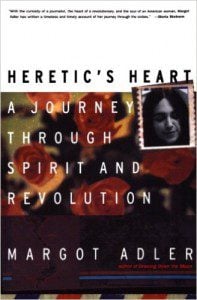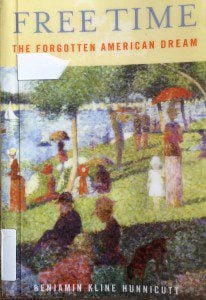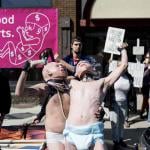Note: This post is part of our Lenten study of Joyce Rockwood Hudson’s book Natural Spirituality: Recovering the Wisdom Tradition in Christianity. Links to the previous installments in this series on “Jungian Spirituality” will be included at the end of each post in this series.
In the evangelical Christianity of my childhood, the major turning point in someone’s spiritual journey was “accepting Jesus Christ as your personal Lord and Savior.” Once you believed that “Jesus died on the cross for your sins,” the rest was downhill. And this decision could be made as soon as soon as you were old enough to comprehend the basics of what it means to follow Jesus. I made this decision and was baptized around age ten, about the same time as many of my friends.
This Lent we’ve been studying a significantly different understanding of the spiritual life. Instead of the next world, the focus is on the just how deep our inner and outer religious experience can be in this world and during this life. Instead of a single decision that can be made even by a small child, the emphasis is an ongoing, lifelong process of spiritual growth that most people cannot even begin to be comprehended until middle age at the earliest.
Many of you will recall the sermon from a few weeks ago that launched this study of Jungian Spirituality. We heard a story from the life of Joyce Rockwood Hudson that radically altered her worldview. Events surrounding the death of a close friend that may have seemed only days ago to be mere coincidences, suddenly resonated deeply with her as meaningful coincidences. In Jungian terms, Joyce was experiencing a “confrontation with the unconscious” (9). She was increasingly open to the ways in which the everyday material world that we experience through our five senses is infused with a larger sense of meaning and purpose. She began to see how experiences in the outer world had strong parallels to her inner experience and vice-versa. And when she examined these resonances between the inner and outer world, she found guidance, insight, and encouragement on her journey toward spiritual growth and greater wholeness. In time, she stumbled upon the writings of Carl Jung, and became increasingly open to the ways that God speaks to us during the day through synchronicities (which is Jung’s term for “meaningful coincidences”) and how God speaks to us at night through our dreams (25). It is no accident that this series of events happened in Joyce’s late thirties, as she entered midlife.
The past few weeks, we have explored the personal unconscious, the Collective Unconscious, dreamwork, and synchronicities. There is much more to say about Jungian spirituality, and I encourage you to read Joyce’s book or one of the other books we’ve referenced if you are interested in exploring these matters further. But for this final part in our series on Jungian Spirituality, I would like to invite us to explore one of the more fun and inventive parts of Joyce’s book: her chapter on the music group The Beatles.
We’re spoken from time to time during this study about the spiritual life as a lifelong journey toward wholeness. And Joyce has an entertaining and significant take on The Beatles’ music career as an illustration of the journey toward masculine wholeness. Jung called this journey toward wholeness individuation: the process of exploring one’s inner self as the path toward growth, maturity, and fully living into a healthy version of the person you alone are uniquely capable of becoming.
Joyce goes into great depth in her book with many nuances and details about The Beatles, but allow me to offer you some highlights. Let’s start with “I Want to Hold Your Hand,” which was The Beatles‘ first number one hit in the U.S. back in 1964:
https://www.youtube.com/watch?v=ipADNlW7yBM
This song is representative of the group’s early period: youthful innocence, young love, and adolescence. The whole message is simple, straightforward, and right there on the surface of the song and of life. The singer simply wants to be physically closer to his object of affection: “I wanna hold your hand.” Notice also that inner affirmation comes not from one’s self, but from another: “When I touch you I feel happy, inside.”
Only a year later in 1965, how much different does the song “Help!” sound? There’s still an underlying, upbeat syncopation, but after skyrocketing to international stardom, the “Fab Four” were clearly starting to feel the stress that comes with moving from adolescence into the pressures of adulthood:
https://www.youtube.com/watch?v=3t8MeE8Ik4Y
In this song we first hear the nostalgia for those carefree days when life was as simple as “I wanna hold your hand,” “Love, love me do” and “She loves you, yeah, yeah, yeah.” Then comes the lament:
When I was younger, so much younger than today, / I never needed anybody’s help in any way. / But now these days are gone, I’m not so self assured, / Now I find I’ve changed my mind and opened up the doors.
Notice also that affirmation and comfort still comes from outside the self:
Help me if you can, I’m feeling down / And I do appreciate you being round. /Help me, get my feet back on the ground, / Won’t you please, please help me.
And now my life has changed in oh so many ways, / My independence seems to vanish in the haze. / But every now and then I feel so insecure, / I know that I just need you like I’ve never done before.
Despite the despondency, Joyce insightfully points out that us that this cry for “Help!” is merely a transition. The real midlife crisis and break comes with the reminiscent song “Yesterday”:
https://www.youtube.com/watch?v=lwS_YDzxH3M
Here, the real reckoning has begun with one’s individual failures, shortcomings, and limits: “Yesterday, all my troubles seemed so far away. / Now it looks as though they’re here to stay.” Notice the use of the word “Shadow,” which resonates with the Jungian term for the personal unconscious: “Suddenly, I’m not half to man I used to be, / There’s a shadow hanging over me. / Oh, yesterday came suddenly.” And, again, the nostalgia for the lost youth: “Yesterday, love was such an easy game to play. / Now I need a place to hide away. / Oh, I believe in yesterday.”
Next, in Joyce’s reading, The Beatles move metaphorically and symbolically into what Jung called the “Second Half of Life” with their album Revolver. (The title itself invokes a connotation of having been spun around.) Consider, in particular, the plaintive characters in the song “Eleanor Rigby”:
https://www.youtube.com/watch?v=k9Itt02QOO0
This song mournfully laments “all the lonely people” from “Father McKenzie, writing the words of a sermon that no one will hear” to “Eleanor Rigby, died in the church / And was buried along with her name / Nobody came.”
At midlife we are forced to confront pain, suffering, and our limitations. The potential fullness of the spiritual life is not a decision made only one time and potentially by even a child. Instead, the journey toward wholeness and spiritual maturity is a lifelong process that often does not begin to fully ripen until midlife when the human capacity to understand limitation and paradox is increased. Accordingly, it is no coincidence that on the same album as “Eleanor Rigby,” we also see aspects of the unconscious explicitly emerging in songs such as “Lucy in the Sky with Diamonds.”
Doubling-down on this path, The Beatles’ next album is called Magical Mystery Tour,  followed by Sgt Pepper’s Lonely Hearts Club Band, the cover of which included none other than Carl Jung himself (he’s on the top row, seventh from the left of a whole host of figures depicted). The larger point is the world watched as The Beatles collectively go through the individuation process that we all individually invited to go through from youthful exuberance to midlife crisis. And hopefully if the midlife crisis is successfully navigated, one emerges into the second half of life with wisdom from the experience and a deeper, more compassionate connection to all of life.
followed by Sgt Pepper’s Lonely Hearts Club Band, the cover of which included none other than Carl Jung himself (he’s on the top row, seventh from the left of a whole host of figures depicted). The larger point is the world watched as The Beatles collectively go through the individuation process that we all individually invited to go through from youthful exuberance to midlife crisis. And hopefully if the midlife crisis is successfully navigated, one emerges into the second half of life with wisdom from the experience and a deeper, more compassionate connection to all of life.
~~~
Having quickly surveyed some insights into The Beatles’ career, I invite you to listen again to our scripture lesson for today from Isaiah 11:
1 A shoot shall come out from the stump of Jesse, and a branch shall grow out of his roots. 2 The spirit of the Lord shall rest on him, the spirit of wisdom and understanding, the spirit of counsel and might, the spirit of knowledge and the fear of the Lord. 3 His delight shall be in the fear of the Lord. He shall not judge by what his eyes see, or decide by what his ears hear; 4 but with righteousness he shall judge the poor, and decide with equity for the meek of the earth; he shall strike the earth with the rod of his mouth, and with the breath of his lips he shall kill the wicked. 5 Righteousness shall be the belt around his waist, and faithfulness the belt around his loins. 6 The wolf shall live with the lamb, the leopard shall lie down with the kid, the calf and the lion and the fatling together, and a little child shall lead them. 7 The cow and the bear shall graze, their young shall lie down together; and the lion shall eat straw like the ox. 8 The nursing child shall play over the hole of the asp, and the weaned child shall put its hand on the adder’s den. 9 They will not hurt or destroy on all my holy mountain; for the earth will be full of the knowledge of the Lord as the waters cover the sea. 10 On that day the root of Jesse shall stand as a signal to the peoples; the nations shall inquire of him, and his dwelling shall be glorious.
About this scripture, Joyce writes:
When viewed through the lens of [Jungian] natural spirituality, these familiar words become a beautiful picture of the individuation process. They offer a symbolic description of what it is like to come to know the wisdom of the unconscious (“a spirit of wisdom, etc.), to do shadow work (“verdict for the poor,” “death to the wicked,” etc.), and to experience the gradual transformation of the conflicting aspects of one’s life into balance, wholeness, and peace (“the wolf lives with the lamb,” etc.). This process is shown to spring forth from earlier faithful living (“the stock of Jesse”). The Messiah when viewed through this lens is understood to be the Self, the divine guidance that arises form within and becomes the new inner center of the individuating person. (250)
Or, in another touchstone phrase, that we’ve considered form time to time: “We are the ones we’ve been waiting for.”
We’ve talked a lot in the past few weeks about how we can grow spirituality by integrating the unconscious into our conscious, waking life through practices such as paying attention to our dreams and synchronicities. But if “We, indeed, are the ones we’ve been waiting for,” the true test comes in the crucible of our own firsthand experience: whether we are able to carve out the time and space to be attentive to how God is speaking to us through our inner and outer life.
In the contemplative silence to follow, I invite to you be open to what this talk of dreams, synchronicities, and The Beatles’ path to individuation may have stirred up within you. Do any memories of dreams or synchronicities emerge from your unconscious? What has resonated with you about your own journey toward individual, wholeness, and spiritual growth.
In the coming weeks, I invite you to be open and attentive to unexpected patterns in your life, meaningful coincidences, and your dreams. You may be surprised what you notice.
For now, I invite you to be still and listen. Or, as The Beatles might say, from the title of their twelfth and final studio album, give yourself permission to experiment for a few moments with what it feels like to let go and simply “Let It Be.”
Previous Sermons in this Series on “Jungian Spirituality for Lent”
- “Confronting the Unconscious: from Supernatural to Natural Spirituality” (Lent 1). Available at http://www.patheos.com/blogs/carlgregg/2012/03/confronting-the-unconscious-from-supernatural-to-natural-spirituality/. An excerpt: “We have to be extraordinarily careful about attributing causation to God and meaning to events. In particular, I am by no means promoting a variation of the harmful canard that, “everything happens for a reason.” But, at least for Joyce Rockwood Hudson, calling these two events “mere coincidences” did not adequately explain the powerful impressiveness of her personal experience. She increasingly had eyes to see and ears to hear “very personal and specific meaning” in events that would have previously seemed coincidental, random, and generic. In Jungian terms, Joyce was experiencing a “confrontation with the unconscious.” And when she examined these resonances between the inner and outer world, she found guidance, insight, and encouragement on her journey toward spiritual growth and greater wholeness.”
- WWJD? (“What Would Jung Do?”): Jungian Spirituality for Lent (Lent 2). Available at http://www.patheos.com/blogs/carlgregg/2012/03/wwjd-%E2%80%9Cwhat-would-jung-do%E2%80%9D-jungian-spirituality-for-lent/. An excerpt: “This scenario does not require or allow for any supernatural control of the weather. Rather, you are invited to consider if we sometimes unconsciously have access to additional level of reality that our conscious minds cannot typically perceive. The more you open yourself to noticing and learning from synchronicities during the day and your dreams at night, the more you may find yourself with breakthrough insights into how to grow toward greater spiritual maturity and personal wholeness.”
- A Dream Uninterpreted Is a Letter from God Unopened (Lent 3). Available at http://www.patheos.com/blogs/carlgregg/2012/03/a-dream-uninterpreted-is-a-letter-from-god-unopened/. An excerpt: “Part of what the writings of Carl Jung invite us to do is pay attention to synchronicities (“meaningful coincidences”) during the day and to dreams at night. The claim, which you are invited to test in the crucible of your own experience, is that the more attentive you are to synchronicities and dreams, the more you will be able to integrate your personal unconscious into your waking life and the more you will be in touch with the wisdom of the Collective Unconscious.”
- Synchronicity, Coincidence, and “Jeff, Who Lives at Home” (Lent 4). Available at http://www.patheos.com/blogs/carlgregg/2012/03/synchronicity-coincidence-and-%E2%80%9Cjeff-who-lives-at-home%E2%80%9D-jungian-spirituality-for-lent/. An excerpt: “Jung invites us to experiment in our own lives with the claim that through practices such as dream work and paying attention to synchronicities (‘meaningful coincidences’), we can catch glimpses of a web of meaning of which our conscious selves are typically unaware. Similarly, Viktor Frankl writes, ‘The only appropriate attitude to such coincidences is to not even try to explain them. I am too ignorant to explain them, and too smart to deny them.’”
Resources on Jungian Spirituality
- Sara Corbett, “Carl Jung and the Holy Grail of the Unconscious,” The New York Times (September 16, 2009). Available at https://www.nytimes.com/2009/09/20/magazine/20jung-t.html?pagewanted=all.
- Carl Jung, Memories, Dreams, Reflections: Jung’s autobiography is arguably the best, most accessible entry point into his writings, which can be difficult to read. The next best step is probably The Portable Jung (The Viking Portable Library), edited by Joseph Campbell. This sampling of Jung will help you discern where you may want to begin to dive into his Collected Works.
- Seedwork.org: a website filled with practical tools for listening to God’s Wisdom in many forms, including dream work, deep prayer, and meditation. Originally created under the auspices of the Episcopal Diocese of Arkansas. A primary site for gaining information about the expanding field of inner journey.
Notes
1 Joyce Rockwood Hudson, the author of our focal book, is the founder and director of the Natural Spirituality Program at Emmanuel Episcopal Church in Athens, Georgia. According to one reviewer, she takes the insights of Carl Jung’s (1875–1961) writings “out of the professional world of the analyst’s office into the everyday world of the laity in the local church. The book offers serious Christians in every community an opportunity to embark on the spiritual path of individuation. With clarity and simplicity Joyce Hudson puts into her reader’s hands the tools for inner work that Jung offered to Christianity. She then goes beyond Jung to present original models of masculine and feminine wholeness.”
2 “It is no accident that this series of events happened in her late thirties, as she entered midlife.” — for more on the “Stages of Faith,” see the references to James Fowler’s model, particularly “Stage 5, Conjunctive Faith” in my sermon “Everything is Holy Now.” Available at http://broadviewchurch.net/2011/09/new-sermon-everything-is-holy-now/.
3 “Second Half of Life” — for more see Richard Rohr’s Falling Upward: A Spirituality for the Two Halves of Life.
4 “We Are The Ones We’ve Been Waiting For” — see my sermon “Harold Camping, John the Baptizer, and Jesus: We Are The Ones We’ve Been Waiting For” (Matthew 3). Available at http://broadviewchurch.net/2011/06/sermon-3/. An excerpt: “Jesus was showing us a way of partnering with God to transform this world through love and justice, compassion and peace. Instead of trying to keep ourselves washed and pure while waiting on God to act (like John the Baptizer) or calculating the date of God’s Judgment Day (like Harold Camping), the way of Jesus invites us to realize, as the old saying goes, that, “We are the ones we’ve been waiting for!” Or, perhaps better, God has all along — until this very day — been waiting for us to us to partner with God in repairing this world through acts of justice and loving-kindness.”
5 “Let It Be” (https://www.youtube.com/watch?v=ajCYQL8ouqw):
When I find myself in times of trouble, Mother Mary comes to me / Speaking words of wisdom, let it be / And in my hour of darkness she is standing right in front of me / Speaking words of wisdom, let it be….
And when the broken hearted people living in the world agree / There will be an answer, let it be / For though they may be parted, there is still a chance that they will see / There will be an answer, let it be….
And when the night is cloudy there is still a light that shines on me / Shine until tomorrow, let it be / I wake up to the sound of music, Mother Mary comes to me / Speaking words of wisdom, let it be.
Let it be, let it be, let it be, yeah, let it be / There will be an answer, let it be / Let it be, let it be, let it be, yeah, let it be / Whisper words of wisdom, let it be.
The Rev. Carl Gregg is a trained spiritual director, a D.Min. candidate at San Francisco Theological Seminary, and the pastor of Broadview Church in Chesapeake Beach, Maryland. Follow him on Facebook (facebook.com/carlgregg) and Twitter (@carlgregg).












